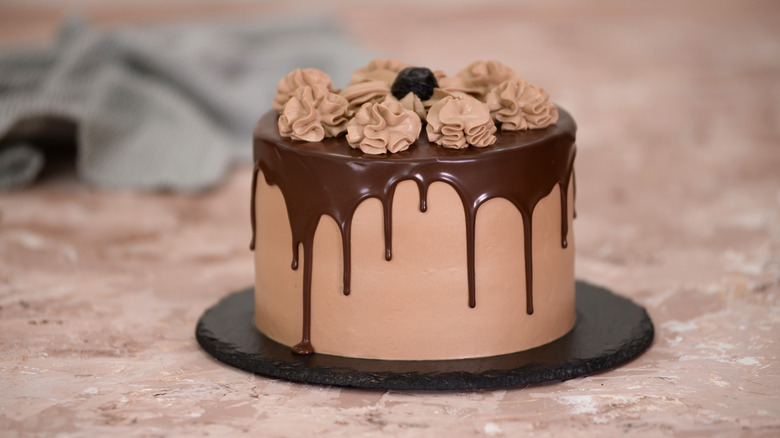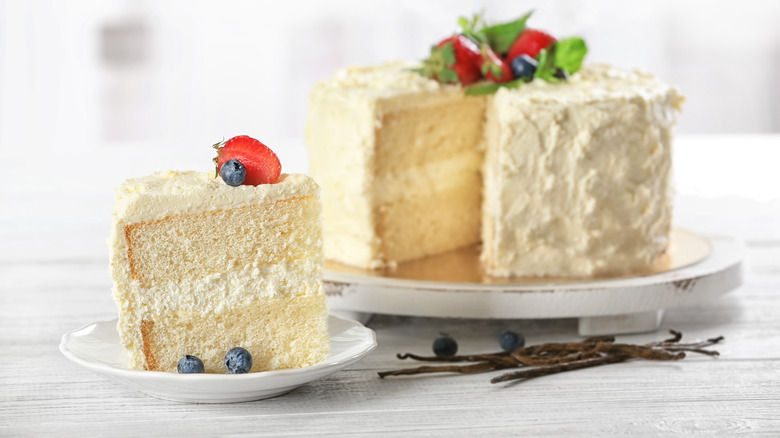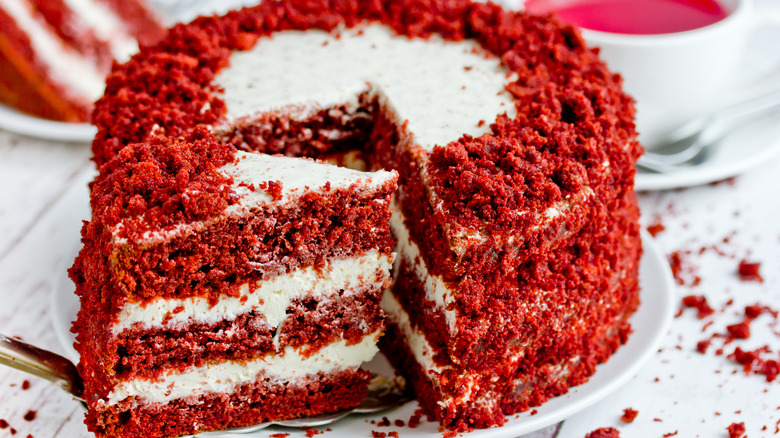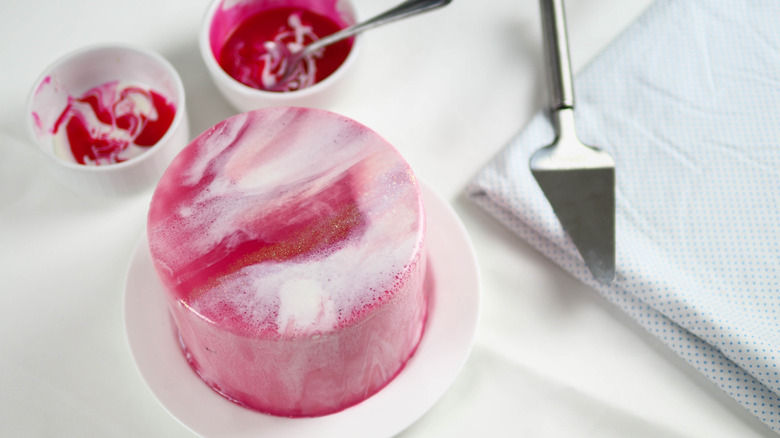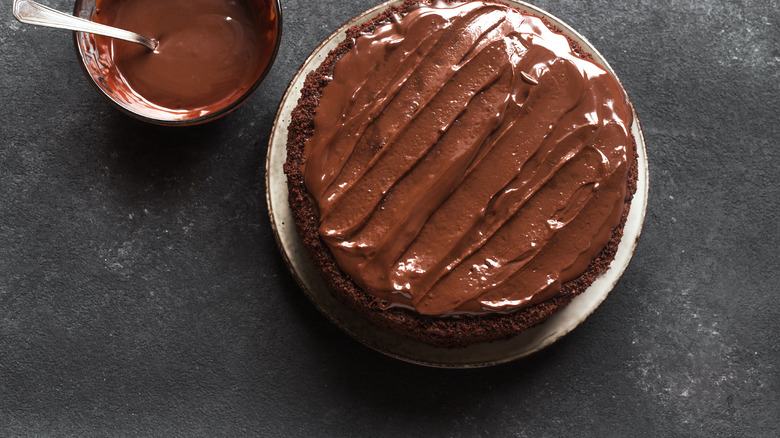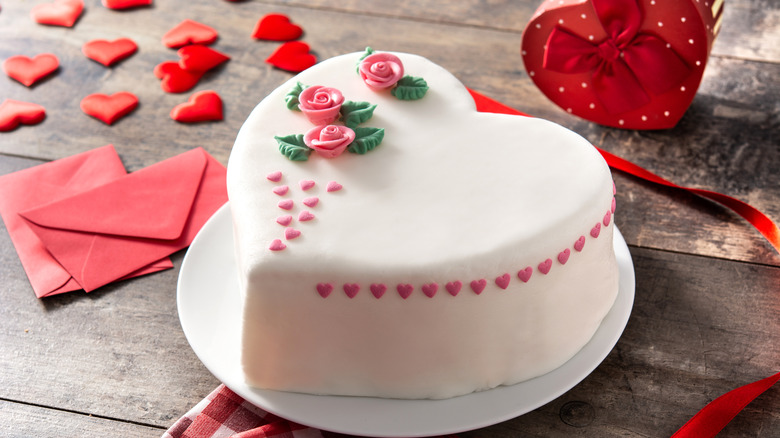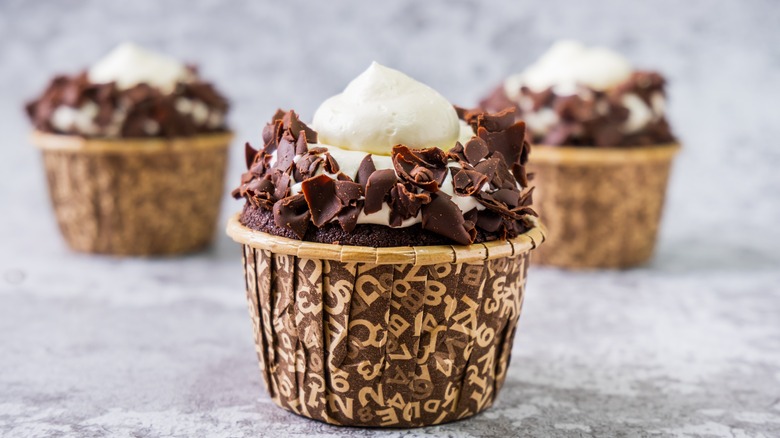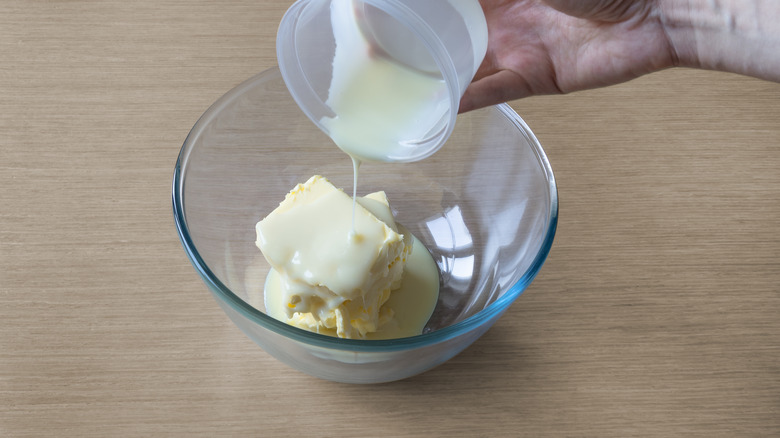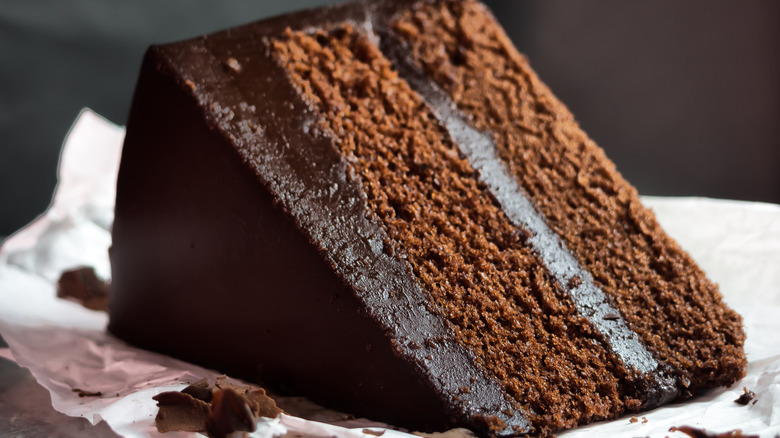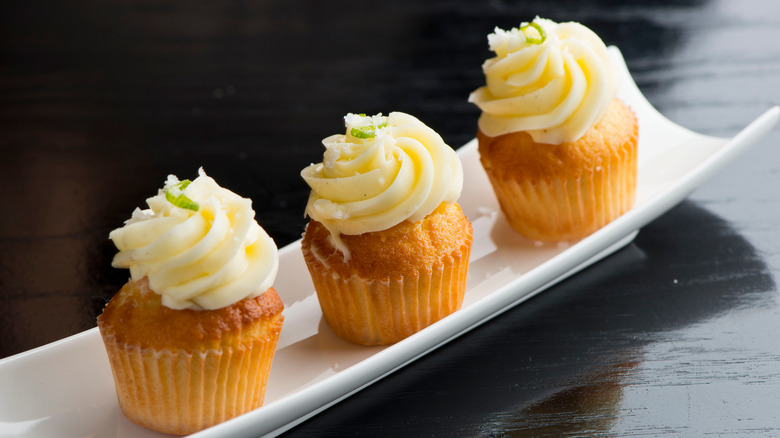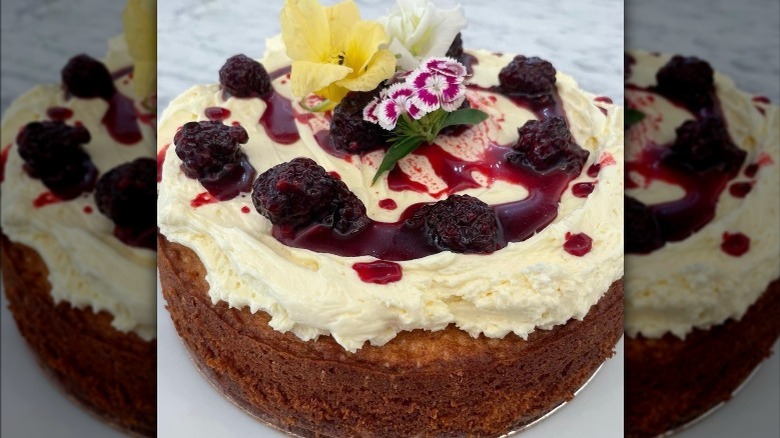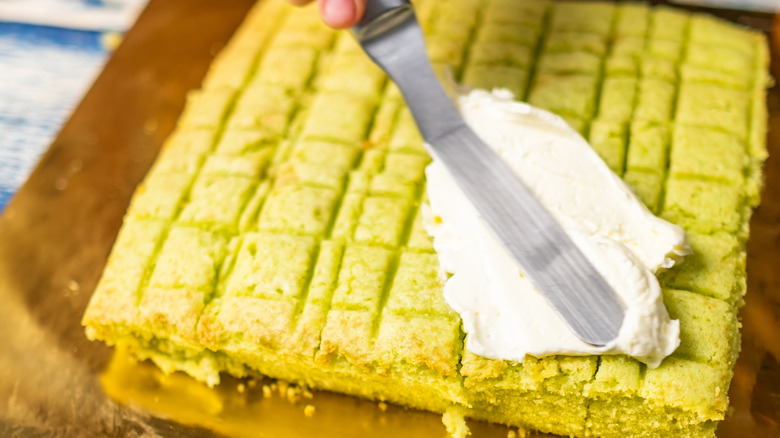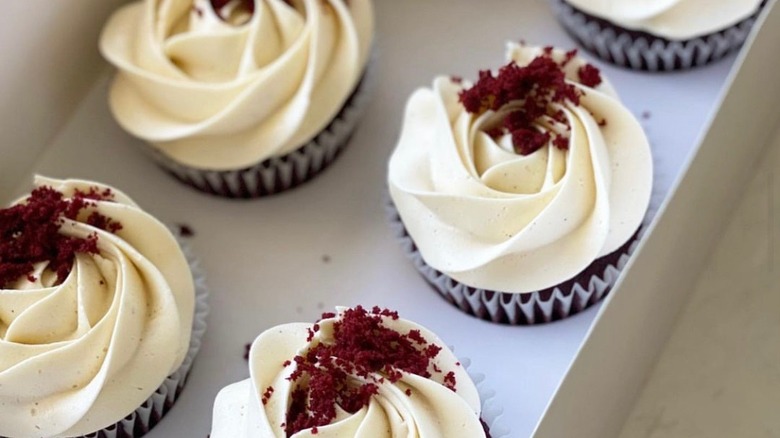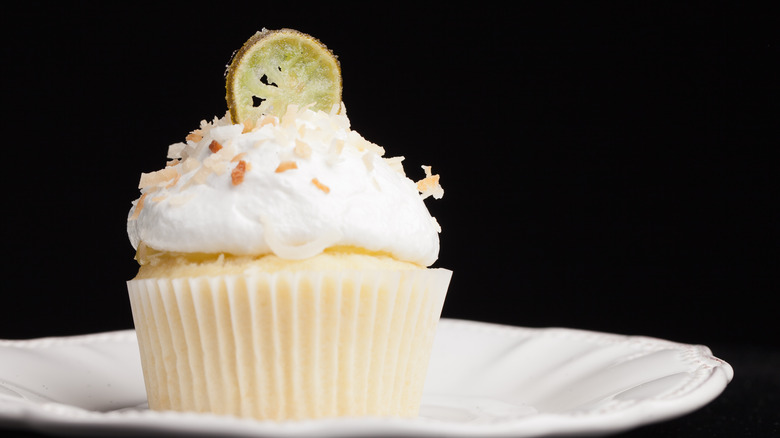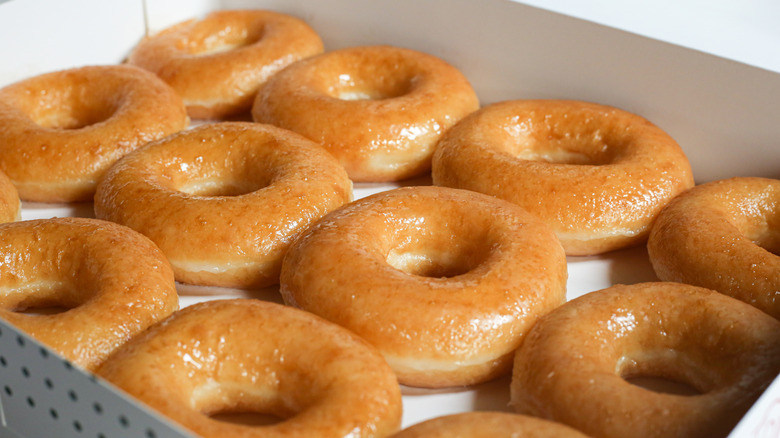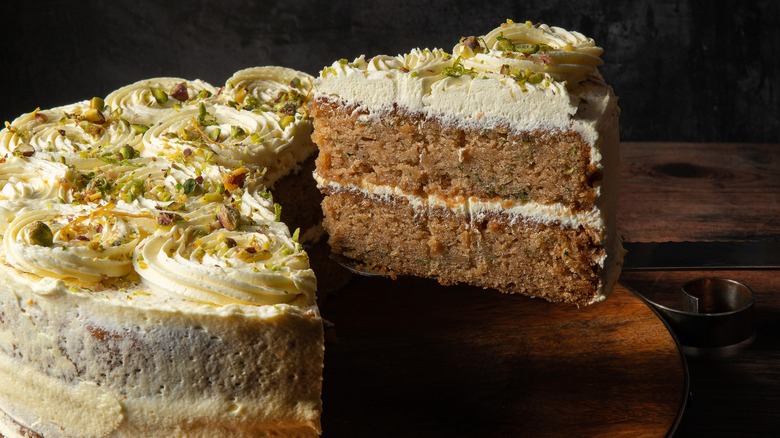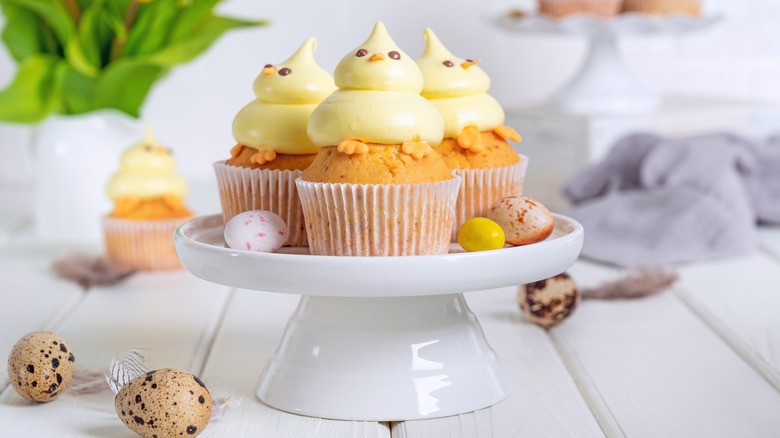17 Types Of Frosting, Explained
There are very few things in the world that go together better than cake and frosting. Nowadays, we think of the elaborately decorated wedding or birthday cake as the status quo for a proper cake, but in all actuality, adding a sweetened frosting or icing to a cake is a relatively novel concept. The Sugar Corner notes that frosting didn't emerge in baking until the 1600s. At the time, the "frosting" was made of sugar and egg whites, which were boiled together and poured onto the cake. After the cake was baked with this frosting, the glaze would emerge as a shiny coating. In the 1800s, as ingredients like sugar and flavorings became more widely available, frosting emerged as a tool for bakers to embellish cakes and add to the rich texture of the baked treats.
In modern times, there are hundreds of different ways to prepare frosting, each of which has a unique texture, preparation, and purpose in a baker's arsenal. We should also note that frosting is much thicker and creamy than icing, which is usually made by combining powdered sugar and a liquid. Regardless of if you choose icing or frosting to adorn your homemade cakes and baked foods, you should know the major differences between the different types of frosting. Here are some of the types you may find in bakeries and home kitchen recipe books.
17. Royal icing
Royal icing is one of the most important decorative tools for cookie bakers. Royal icing was originally used to decorate fruit cakes and elaborate wedding cakes, but has since been modified to be one of the most ubiquitous types of frosting in the kitchen. Royal icing is characterized by a hard exterior, which used to be smashed with a small hammer on a British royal wedding cake.
The structure of royal icing is made possible by the addition of egg whites (often as meringue powder), water, and confectioners' sugar. Some folks will also add glycerin, corn syrup, or glucose to the mixture to soften its flavor or to add a signature shine to the royal icing. You'll find many cakes embellished with royal icing, but its hard texture often makes this icing a choice for small decorations or piping onto cookies. The structural integrity of royal icing makes it a popular choice for assembling gingerbread during the holidays.
16. Whipped cream frosting
Whipped cream frosting is a characteristically light frosting made by whipping air into a base of heavy cream and powdered sugar. Meringue powder is occasionally added to the frosting as a stabilizer. However, this does not mean that whipped cream frosting is the sturdiest of frosting types. If you use this frosting in replacement of buttercream between a dense carrot cake, you'll deflate the icing and cause the cake to sink.
Buttercream also has a different and much more rich flavor than whipped cream frosting — buttercream is made with solid butter after all. Since whipped cream frosting is less stable than a meringue-based or buttercream frosting, it cannot be piped onto cakes and cupcakes as easily. The Cake Decorist notes that since air is beaten into the icing, the icing tends to deflate under warm conditions. If you're making a delicate vanilla cake with fruit and a layer of whipped cream frosting, you should be prepared to allocate a lot of space in your refrigerator to keep your cake cool and stable.
15. Cream cheese frosting
If you think of red velvet cake, you probably think of cream cheese frosting too. Cream cheese has a similar structural integrity to buttercream because it is made with another solid (and tangy) dairy product: cream cheese. The cream cheese is whipped at a high speed with powdered sugar, softened butter, vanilla extract, and a pinch of salt to develop this sturdy frosting that can be used to decorate carrot cakes and homemade cinnamon rolls too. You might even try adding a schmear of this frosting to your homemade banana bread after it's cooled, as well.
Cream cheese frosting was invented in the 1800s but didn't become gain significant popularity until the 1960s when cream cheese became more widely stocked on grocery store shelves. Arla, a leading producer of cream cheese, elected March 31 as National Cream Cheese Frosting Day in America (via Days of the Year).
14. Mirror glaze
A well-done mirror glaze is one of the modern marvels of the baking world. The cake you use for a mirror glaze must be frozen solid and have a smooth crumb coating to ensure that the glaze covered the entire cake. The glaze itself is made by heating gelatin (either powdered granules or sheets), water, condensed milk, granulated sugar, and white chocolate to between 90 and 95 degrees F (via MyRecipes). Then the glaze is poured onto a cake and allowing the glaze to set for a few minutes. The result is a sheen layer of reflective glaze that will impress your dinner guests and surely lead to a few Instagram posts.
While mirror glaze is stunning to look at, it is not the ideal texture for eating. The gelatin in the recipe, combined with the sheer volume of sugar in the glaze, makes this glaze have a mouthfeel of bubblegum.
13. Chocolate ganache
Chocolate ganache is a chocolate lover's dream. This frosting is made with a 2-to-1 chocolate-to-cream ratio. Besides these two staple ingredients, ganache includes the addition of butter for richness, corn syrup for shine, or liqueurs for flavor. Ganache can be used in both a liquid state, as a chocolate sauce on ice cream, or as a frosting that can be used to ice cupcakes or whipped into other ingredients. Cooling ganache also allows it to be rolled into truffles.
Bakerpedia notes that there isn't one clear origin story for this frosting. The two major countries claiming ownership over this dessert include Switzerland and France. One particular origin story for this sweet dessert, which centers around the latter country, claims that a French patisserie apprentice spilled hot cream into a bowl with chocolate. His supervisor angrily called him "un ganache," which roughly translates to "idiot." The supervisor rescinded his comment after trying the apprentice's concoction.
12. Fondant
Fondant is usually used as a cake-designing tool rather than as a tasty frosting. This spongy, plasticky frosting is made by combining sugar, water, and corn syrup — but some more simplistic recipes involve combining melted marshmallows and powdered sugar. The fondant is rolled out into a sheet before being cut and shaped into delicate roses or creative edible figurines. Although fondant is sturdy and able to hold up to warm temperatures more reliably than a cream-based frosting, fondant is usually not the top choice for taste. It tends to be blander than cream-based frosting, so bakers often have to rely on flavoring agents to make the fondant palatable.
There are two major types of fondant: clay-like rolled fondant and gelatinous poured fondant. Poured fondant is more commonly used as a frosting or filling for eclairs or Napoleons while rolled fondant is used to shape designs for cakes. According to Cake Made Blog, the first use of fondant in baking dates back to the 1500s. At the time, fondant was made from ingredients like rose water, egg whites, and lemon juice. Eventually, fondant was used with almond-based marzipan to decorate cakes from the 1600s into modern times.
11. Italian meringue buttercream
Italian meringue buttercream is a highly-stable frosting made by mixing a simple syrup (made of water and granulated sugar) and stiffly beaten egg whites. Then, the meringue is incorporated with butter and a bit of vanilla extract for flavoring. Italian meringue, without the buttercream component, is the most stable type of meringue because the piping hot syrup cooks the egg whites as its poured in. The inclusion of other ingredients in the Italian meringue buttercream dilutes some of the sweetness from the sugar.
Italian meringue buttercream is the secret ingredient in Ina Garten's devil's food cake. The icing for this cake is flavored with a splash of coffee liqueur along with the traditional Italian meringue buttercream. When working with this kind of buttercream, it is important to keep air moving through the simple sugar and egg mixture to cool it. If the mixture is not cool enough by the time you add the butter, you'll find the buttercream splats and melts.
10. Russian buttercream
Russian buttercream, which is otherwise known as condensed milk buttercream, is made by combining butter, sweetened condensed milk, vanilla, and salt. The sweetness in the icing is purely derived from the sweetened condensed milk; there's no additional sugar beaten into the frosting. Additionally, the sweetened condensed milk adds a profoundly milky and caramel undertone to this icing. The color of sweetened condensed milk is also not purely white, so you should expect your Russian buttercream to come out a little more cream-colored than a white-as-snow buttercream.
For the most part, Russian buttercream frosting is easy to pipe. However, since sweetened condensed milk is a liquid ingredient, altering the ratio too much can produce an icing that is better suited for flooding than for piping. Since sweetened condensed milk is shelf-stable and butter can be left out at room temperature safely for a few hours, it is permissible to frost a cake with sturdy Russian buttercream and leave it out for some time before cutting and enjoying.
9. Fudge frosting
Fudge frosting is admittedly dense, but it's too good not to devour. A fudge frosting is a hybrid between a decadent buttercream and a thick, unctuous candy-store fudge. Although chocolate is one of the most common flavors of fudge frosting, this type of frosting can be flavored with other ingredients like orange and fruit. Besides the standard frosting ingredients of milk, butter, and sugar, fudge frosting includes (often unsweetened) melted chocolate and cocoa powder. These chocolatey ingredients add an important malleability to this type of frosting. Fudge frosting is undeniably best paired with a dense chocolate layer cake — just keep a cold cup of milk nearby if you get overwhelmed by how rich the dessert is.
Making fudge frosting can be deceptively easy, especially because the sugar crystals tend to harden with fudge icing and gives the icing a grainy texture. Using powdered sugar instead of granulated sugar can prevent this, as well as using a candy thermometer for accurate heating and slowly increasing the heat on the double boiler used to melt down the chocolate.
8. French buttercream
You guessed it, we're going on a tour of Europe by way of frosting. French buttercream is unlike other types of frosting because it uses pasteurized egg yolks for flavor, structure, and richness. The texture of this frosting is similar to pastry cream or custard. French buttercream is also usually less sweet than American buttercream, which makes the icing a perfect pairing for an especially dense gluten-free chocolate cake. Or use French buttercream as a mildly-sweet cupcake frosting that won't make your teeth hurt.
Besides its creamy flavor, French buttercream is easily recognizable by its yellow tint. The inclusion of yolks and butter are vital contributors to this color, so a baker must be keenly aware of how the tint might alter the appearance of the final product. The high butter content in this icing makes it a good fit for spreading in between layer cakes or piping with a high degree of definition.
7. German buttercream
German buttercream is made of a flavorful, vanilla custard base and less sugar than other types of buttercream. The custard is made from the same ingredients you would use to make custard for ice cream or an elaborate cake filling. You'll find milk, sugar, egg yolks, vanilla extract, cornstarch, flour, and salt included in the custard before it's mixed with the butter that makes buttercream— well — buttercream. Although German buttercream takes a bit more time to make because of the vanilla custard, the delicate, smooth texture is totally worth the extra time.
The Germans are believed to be one of the first groups to pioneer the buttercream recipe, per Cheryl's. Buttercream became a staple in the country in the 1940s and spread beyond the country's borders since. And with the delicious, soft, and buttery flavor of German buttercream, it's hard not to jump on the global buttercream bandwagon.
6. Swiss meringue buttercream
Swiss meringue buttercream is a bit more complicated than German buttercream. Swiss meringue is made with egg whites and sugar beaten together over a double boiler, before being thickened with butter. This type of meringue is relatively flexible and can be flavored with everything from extracts and liqueurs to coffee and chocolate. Swiss meringue is relatively stable but does not have the same structural integrity as Italian meringue buttercream.
Swiss meringue is popular for cake decoration because it has a silky texture and can sit on the counter for one to two days before eating. It can also be frozen for up to three weeks. Swiss meringue buttercream can also be colored with gel food coloring. Some variations on this recipe can include adding homemade lemon curd or strawberry puree to the buttercream after it's been mixed, both of which will add both texture and tangy, fruity flavors.
5. Ermine frosting
Ermine frosting is otherwise known as flour frosting, milk frosting, or flour buttercream. It can also be called American frosting, but ermine frosting is made using a different process than its American counterpart. Ermine frosting is first made with a roux of flour and milk. Then, granulated sugar is added for an element of sweetness. After the mixture has cooled enough, the butter is whipped and the sugary roux is slowly added. The resulting mixture is smooth, fluffy, and perfect for a freshly baked batch of cupcakes.
Ermine frosting emerged in the baking lexicon in the 1800s as a pairing for chocolate Mahogany cake — a precursor to the red velvet cake. According to Masterclass, the frosting was named after a white-colored weasel and was popular among bakers for its richness and mild sweetness. It also does not require the baker to make a time-consuming custard or meringue like a German buttercream or an Italian or Swiss meringue buttercream.
4. Seven-minute frosting
Did you know one of the best types of frosting you could ever make only requires seven minutes of your time? Despite this namesake, making seven-minute frosting requires a few special steps to make sure the kitchen equipment is ready to go. Egg whites, sugar, cream of tartar, salt, and water are beaten in a double boiler for about seven minutes until stiff peaks form. With time, the icing will start to get fluffy and soft, making it a delicious pairing for cupcakes and as a layer on the outside of a birthday cake.
The cloud-like texture of the seven-minute frosting wouldn't be possible if there is any residual oil or soap on the handheld beater attachment, so the baker has to be keen to meticulously clean their space before making the seven-minute frosting. The rigid structure of the egg whites after the double boiler also needs to be put on baked goods quickly because the frosting has a tendency to set quickly.
3. Glaze
When you think of "glaze" you likely think of a box of fresh sugary donuts or a Christmas ham. The glaze in both of these examples is much thinner than what we think of when we think about frosting. Glazes usually include ingredients like powdered sugar, corn syrup, and vanilla extract mixed to form a sugary coating on baked goods. However, icing (think royal icing) sets faster than a glaze because it has higher sugar content. Both glazes and icings are treated slightly differently than frosting as well; the former are poured onto baked goods while frosting is usually spread with a spatula because of its thickness.
Occasionally, glazes will include fruit juice, such as an orange glaze on a cranberry orange muffin. The juice provides a punch of tangy flavor while also keeping the glaze liquid enough to limit hardening. The nature of powdered sugar, though, means that there will be some degree of hardening. Adding more moisture and limiting the sugar will reduce this phenomenon.
2. Decorator's buttercream
The ideal frosting for decorating is one that is thick, pipable, and can be made in advance. In walks decorator's buttercream, which is made by substituting vegetable shortening for butter in a traditional buttercream recipe. Vegetable shortening, which is made from hydrogenated vegetable oils, is the perfect addition to the frosting because it is more stable than animal-based frosting. Vegetable shortening does not melt as profusely as butter, meaning that it won't slosh and ooze off your cake like a traditional buttercream. If you're baking in a warmer climate or plan to leave your frosted cake out for a long period, shortening can be your new best friend. We could all use a little extra frosting stability in our lives.
Decorator's frosting can also be made vegan because the shortening is derived from plant-based sources. Just be sure to use vegan sugar and stick to plant-based milk if you need to thin the frosting.
1. American buttercream
American buttercream is the overtly sweet and pure confectionary bliss that children dream about. The frosting that most people associate with the word buttercream is made by whipping butter in a stand mixer until it's creamy before adding the confectioner's sugar, milk, and vanilla extract. American buttercream is often the sweetest of buttercreams, with the ratio of sugar to butter being as high as 4-to-1.
If you plan to use this recipe for a children's birthday cake, you likely won't have to alter the amount of sugar in the recipe. The amount of sweetness is just right for sugar-loving partygoers. But if you want to be able to eat more than one slice of cake, either stick to using a thinner layer of frosting on your cake or decrease the ratio of sugar to butter. For easier piping, you can add milk incrementally to thin out the frosting.
